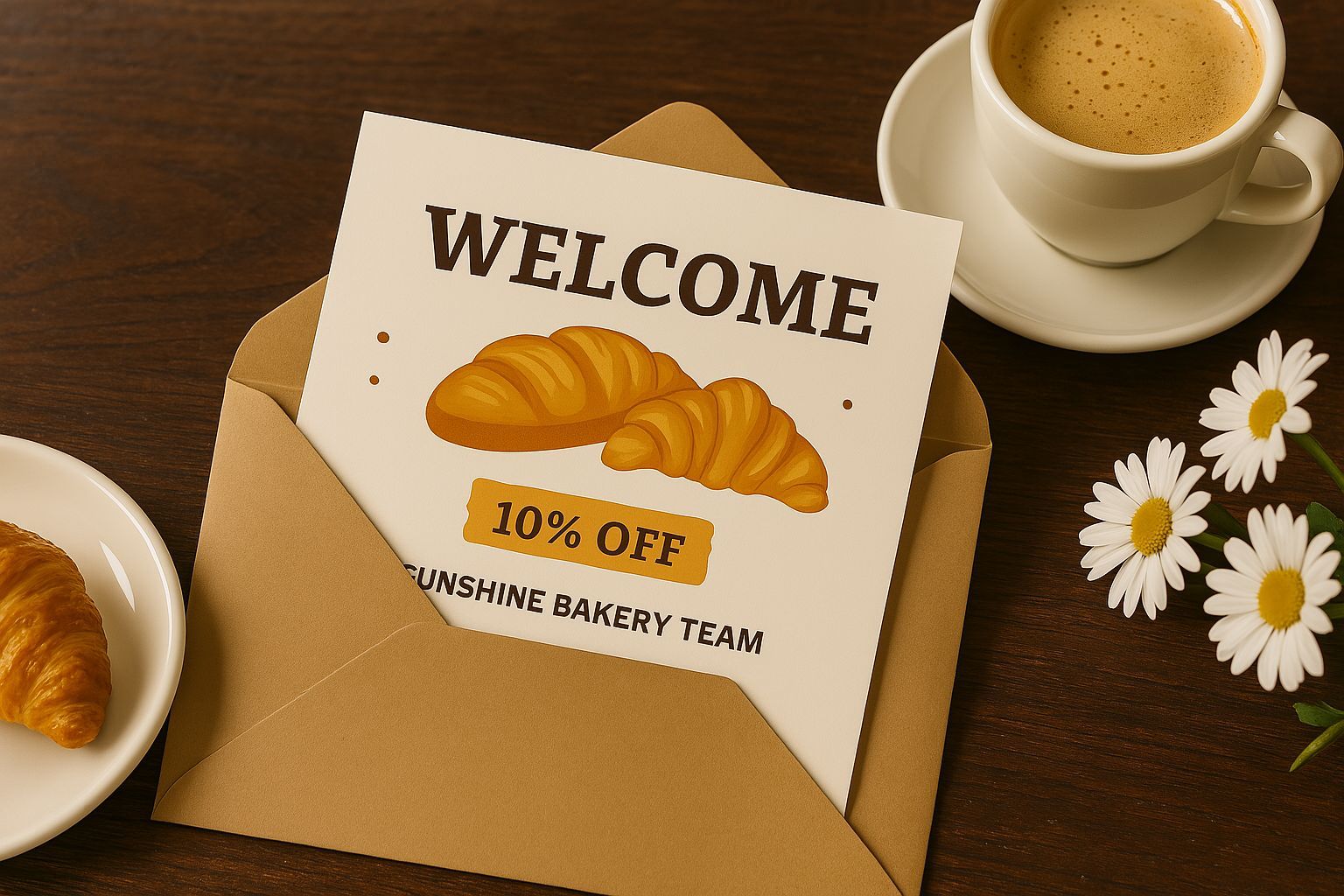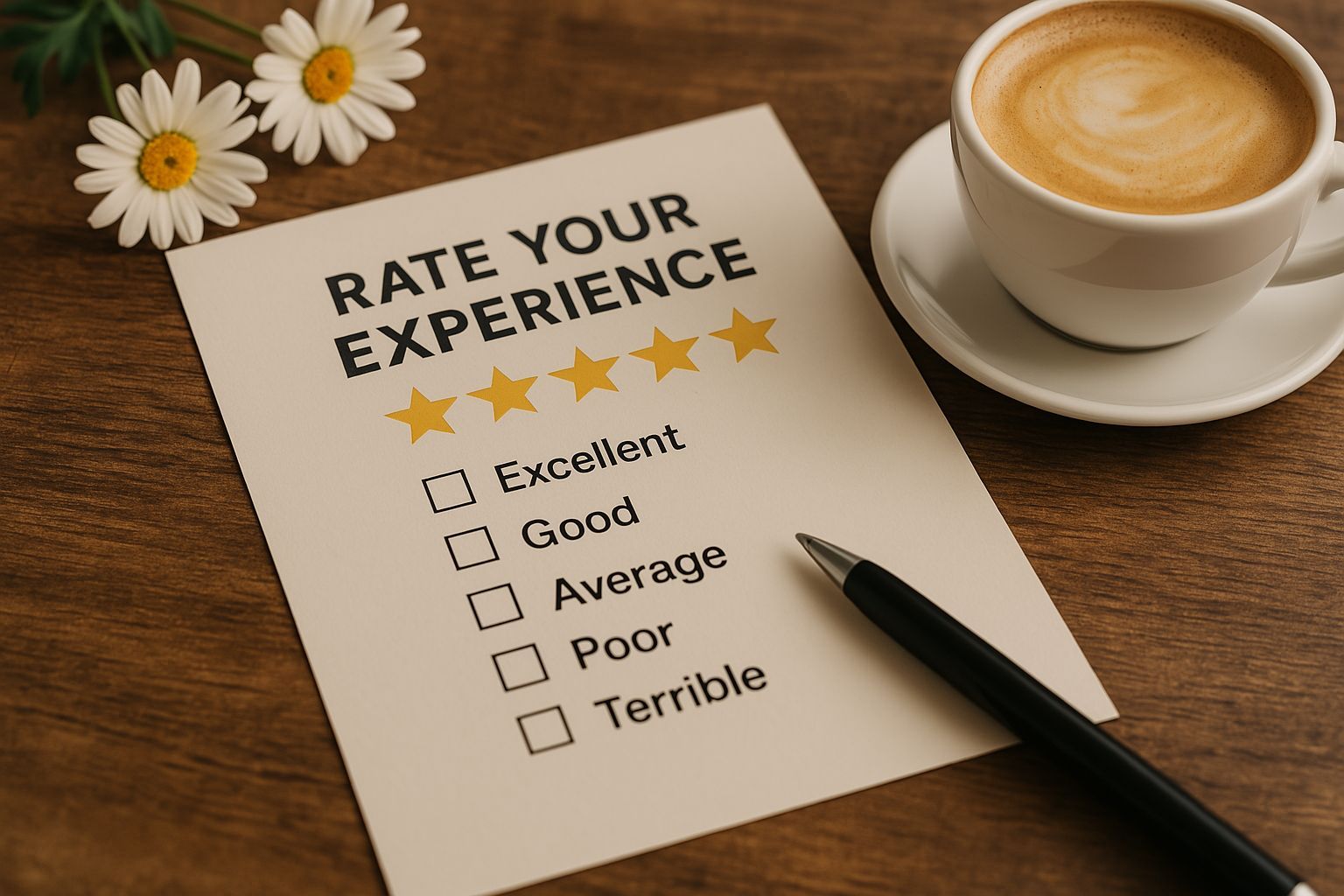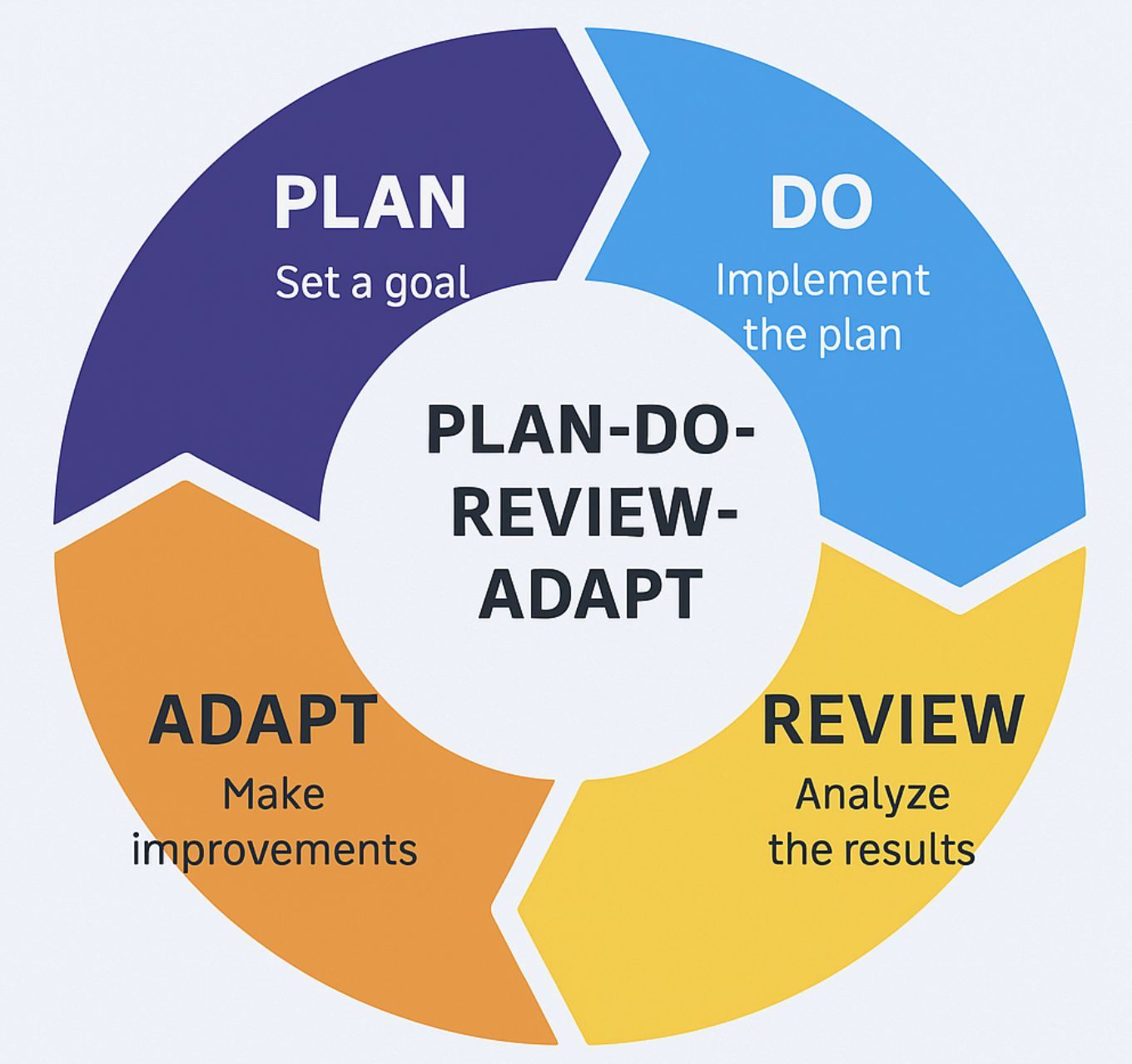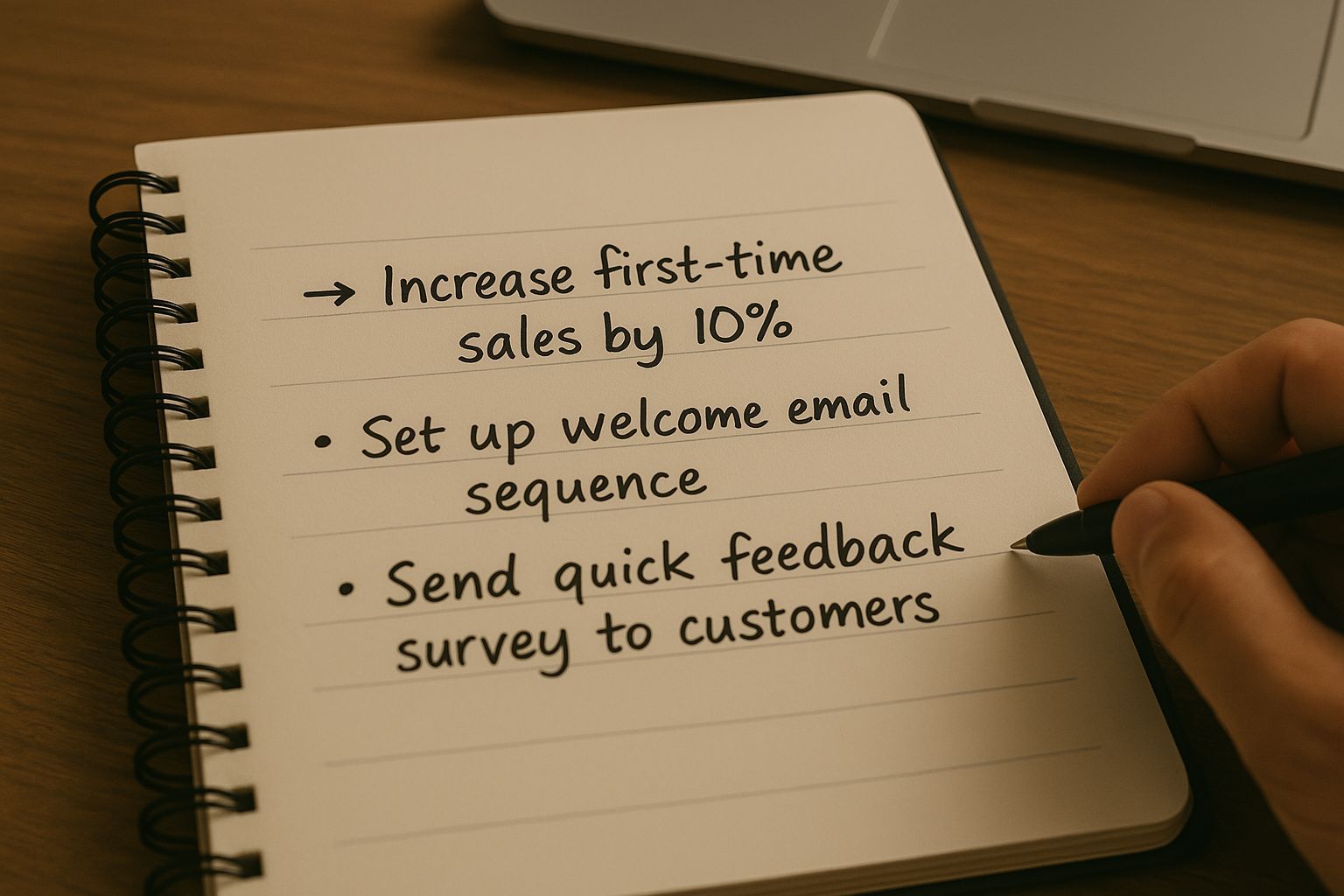Contents
the email tool that makes email marketing simple
Email Marketing Objectives: A Practical Guide to Measurable and Lasting Results
Published: April 9, 2025
Why Email Marketing Objectives Matter
Have you ever spent hours perfecting an email newsletter—tweaking each word, handpicking images, and triple-checking every detail—only to hear nothing but silence afterward? You’re not the only one. Many small business owners invest valuable time in email campaigns but struggle to achieve meaningful results.
The reason is simple: sending emails without clearly defined objectives of email marketing seldom works. Without these objectives, your messages quickly become random and disconnected, blending into background noise instead of prompting meaningful interactions. Having clear email marketing objectives changes this. Each email you send now has a specific purpose, allowing you to measure exactly what's working and adapt quickly if something isn't.
When your emails consistently match your subscribers' real interests and current needs, they'll start paying closer attention. Instead of being ignored, your emails become anticipated—full of genuinely helpful tips, timely discounts, or valuable insights that subscribers want.
Ready to make that happen? In this practical guide, you’ll discover how to set clear email marketing objectives tailored to support your small business's growth. You’ll learn how to attract new subscribers, turn leads into first-time buyers, boost repeat sales, and cultivate long-term customer loyalty. You'll find hands-on tactics, straightforward tips, and real-world examples you can start using right away.
Before we get into specific email marketing objectives, let’s pause. To get results, your email marketing objectives must directly support your broader business objectives. Let's quickly look at how you can define these business goals clearly, so your email marketing efforts align perfectly with your overall strategy.
How to Clearly Define Your Core Objective
Before you can set effective email marketing objectives, you first need clarity about your overall business goals. Email marketing doesn’t stand alone—it's just one piece of your broader digital marketing strategy, which itself supports your business’s main objectives.
Too often, small businesses jump straight into email marketing without clearly defining these larger goals first. Consequently, their efforts might produce occasional good open rates or subscriber counts, but without clear alignment to bigger goals, these successes don’t translate into meaningful business results. Even worse, you might waste valuable time moving in the wrong direction entirely.
To avoid this trap, start by clarifying your core business goals. These are the overarching targets that shape your entire business, such as:
- Increasing monthly revenue by 15%
- Reducing customer churn to below 5%
- Gaining 500 new paying customers this quarter
These core goals guide every aspect of your marketing, including email. Once you’ve defined them, you can align your email campaigns to actively support the bigger picture—making every message count toward real progress.
Quick Exercise: Identify Your Core Goal
Take a moment to ask yourself:
- What’s your biggest business priority? Attracting new customers, increasing sales, or improving retention?
- If you could achieve just one major goal this quarter, which would make the greatest difference for your business?
Answering these questions helps you pinpoint what your email marketing needs to achieve first. With this clarity, you're ready to set specific, meaningful email marketing objectives that directly support your overall business growth.
Key Email Marketing Objectives and How to Reach Them
Now that you've clarified your core business goals, you can define specific email marketing objectives that actively support these larger targets. Depending on your business’s current needs, you might focus on attracting new subscribers, turning leads into first-time buyers, nurturing hesitant prospects, boosting repeat sales, or retaining existing customers.
Each objective is designed to support your overall business growth, whether you're just starting, have an established business, or are reviving your marketing strategy after some time away. Choose the objective that aligns most closely with your current priority, or explore several to build a comprehensive, targeted approach.
Build and Engage a Target Audience
This is the foundation of all successful email marketing. Creating an engaged subscriber base is critical. For newer businesses, it helps you establish your presence and build brand awareness. For more established businesses, it maintains growth and momentum.
By attracting the right email recipients and consistently providing valuable content, you'll foster strong relationships—leading to increased loyalty, trust, and ultimately, greater sales.
Watch More How To Build An Audience With Zero Followers (Dan Koe) This is How to Grow Your Audience in 2025 (Marketing by Shelby)
The Value of a Real Community
Your subscribers should feel connected to your brand and eagerly anticipate your emails.
Returning to our fitness studio example, imagine you start offering subscribers a free downloadable guide titled "5 Simple Home Exercises to Boost Your Energy." Now, you’re no longer just asking visitors to join a mailing list—you're giving them something genuinely useful upfront. People who download this guide are likely interested in improving their fitness and well-being, making them more engaged subscribers.
This targeted approach doesn't just increase your subscriber count; it also creates a deeper connection. Your emails will now reach a community that values your content, making them more likely to open future emails, attend classes, and trust your brand.
Tactics to Gain Subscribers
Now that you understand the importance of building an engaged community, it's time to get practical. Growing your subscriber list simply involves using the right tactics. Below are three straightforward approaches you can implement quickly to attract subscribers who are interested in your content:
Simple Website Forms
Place clear, easy-to-use signup forms prominently on your website, requiring minimal effort (usually just name and email).
Offline Signup Methods
Leverage face-to-face interactions—use signup sheets or QR codes at checkout counters, local events, or trade shows.
Social Media Teasers
Share compelling social posts that tease your lead magnet’s value, making subscribers feel they're getting something truly useful.
You’ve already seen how offering a valuable free guide helped a fitness studio attract engaged subscribers. This tactic also works well for other businesses.
Imagine a bakery wants to attract more engaged email subscribers. They create a practical guide titled "5 Secrets to Perfect Bread at Home." After promoting this guide consistently on Facebook and Instagram, they see their newsletter sign-up rate jump by 2.5% in just a few weeks. Customers appreciate valuable tips rather than generic promotions, resulting in truly interested subscribers.
Watch More Grow your email list from scratch (2025 beginner guide)
Engage Subscribers from the Start
Getting subscribers to join your email list is just the first step. To build a lasting relationship, you need to keep them engaged right from the beginning. One of the most effective ways to do this is by sending a personalized welcome email immediately after they subscribe. This first message sets the tone, making subscribers feel valued and eager to hear from you again.
Send a Personalized Welcome Email
Sending a friendly, personalized greeting immediately after subscribers join your list makes them feel welcomed and appreciated.
Here's how a warm, personal welcome email might look:
Subject Line: Welcome! Here’s 10% off your first croissant!
Body:
Hi {{first_name}}!
We're so happy you've joined our bakery community—thank you for subscribing!
As a special welcome gift, please enjoy 10% off your next visit. Just show this email at checkout or use the code WELCOME10 online.
We can’t wait to see you soon!
All the best,
The Sunshine Bakery Team
This type of simple yet genuine greeting immediately creates goodwill, encourages that first crucial purchase, and sets the stage for ongoing positive engagement.
With a community of subscribers who feel connected and valued, your next goal is guiding them smoothly toward making their first purchase.
Read More Better Triggered Email: 5 Ways to Engage New Email Subscribers Instantly
Convert Leads into First-Time Buyers
Turning interested subscribers into paying customers is unlocks real growth—but it is one of the biggest challenges in email marketing.
Overcome the First-Purchase Hurdle
How can we encourage subscribers to take the leap and make their first purchase? Even after building trust, many subscribers still hesitate.
For small businesses especially, overcoming this "first-purchase hurdle" is vital. Your email marketing can’t truly drive growth until subscribers make that first purchase.
Imagine you’ve launched a new online apparel boutique. You've successfully grown your subscriber list and see promising engagement. Yet, despite many sign-ups and active readers, no one has placed an order. Your subscribers are interested, but something’s preventing them from taking that critical final step.
Understand that hesitation is normal—and your emails need to gently and strategically nudge subscribers forward with timely, relevant reasons to buy.
Strategies to Drive Initial Sales
To help subscribers overcome this hesitation, here are three proven tactics:
Drive Sales with Limited-Time Discounts
Provide a compelling reason for subscribers to act now by offering a time-sensitive discount or special promotion. People often subscribe specifically looking for deals.
Example:
"Enjoy 15% off your first order—but hurry, this exclusive offer ends in 48 hours!"
Recover Abandoned Sales with Automated Reminders
Many subscribers get close to buying but leave their carts or booking forms without completing the transaction. About 70% of online shopping carts are abandoned—yet over half of reminder emails sent afterward are opened and often lead to completed purchases. Set up automated emails that send shortly after abandonment, ideally within an hour, to recover these potential lost sales.
Example:
"Did you forget something? Your items are still in your cart—return now and complete your order!"
Boost Trust with Customer Testimonials
Testimonials or reviews from happy customers can significantly reduce hesitation. When potential buyers see that others have successfully purchased and enjoyed your products or services, they feel safer making their first purchase.
Example:
"See why hundreds of customers love our jeans: 'These are the comfiest jeans I’ve ever worn!' – Emma W., Customer since 2021"
In Case You Missed the Main Point!
Over 50% of abandoned-cart reminder emails get opened—and many directly lead to completed purchases. If you’re not sending these reminders yet, setting them up is one of the quickest ways to boost your sales.
Onboard New Customers Successfully
Immediately after someone becomes a customer, your priority should be ensuring they have a positive, confident start. Effective onboarding demonstrates your product's value, sets expectations, and creates a reassuring experience—laying the groundwork for long-term satisfaction and loyalty.
Ensure a Smooth Post-Purchase Experience
When a customer first makes a purchase—especially for SaaS or subscription-based businesses—their journey with you is just beginning. This initial experience is critical for ensuring long-term satisfaction and customer retention. Although your customers might initially feel excited about their purchase, uncertainty can creep in. An effective onboarding sequence helps overcome this hesitation by demonstrating how to use your product and showcasing the full value customers can expect.
An onboarding email series should include helpful tutorials, step-by-step instructions, and friendly support messages. The goal is guiding your customers comfortably through the first steps, addressing common questions proactively, and reinforcing their decision to purchase.
By ensuring customers feel supported and informed right from the start, you significantly reduce churn and boost satisfaction—leading to stronger, longer-lasting relationships.
Checklist: Create Effective Onboarding Emails
Use this quick checklist to create impactful onboarding emails:
- Simple welcome message: Start with a warm, friendly greeting. Thank customers for their purchase and briefly explain what happens next.
- Step-by-step tutorials: Provide clear, easy-to-follow instructions for getting started with your product.
- Helpful FAQ links: Anticipate common questions and provide quick links to detailed answers.
To simplify this process, consider automating these onboarding emails with an email marketing platform like Maildroppa.
While effective onboarding sets new customers on the path to success, remember that not every subscriber or lead is ready to buy immediately. Your next priority is nurturing those who are interested—but still hesitant—to guide them smoothly toward their first purchase.
Read More Customer Onboarding: Steps, Examples, and Best Practices (Help Scout)
Nurture Hesitant Subscribers
It's normal for subscribers to hesitate before purchasing. Often, they're simply looking for reassurance, extra information, or time to build trust. Consistent and patient nurturing can significantly boost your conversions and customer loyalty, especially for small businesses where every subscriber counts.
Understand Why Subscribers Hesitate
To address subscriber hesitation effectively, first understand the reasons behind it. Say you're running an online photography course: your email list is growing, and subscribers regularly engage with your newsletters, but only a few enroll in your paid courses. Curious about what's holding them back, you send a quick survey asking what would make them feel ready to enroll.
Their responses might reveal something crucial—for example, subscribers often need more evidence that your course will truly improve their skills before they invest. In response, you create a short email series offering practical photography tips, student success stories, and free mini-lessons, all without aggressive selling.
Within weeks, subscribers previously on the fence begin enrolling. This illustrates a fundamental principle: Subscribers become customers when they're ready. Their readiness often grows naturally when you provide consistent, valuable content that addresses their doubts.
Nurture Subscribers Using Drip Campaigns
One highly effective method to nurture subscribers and guide them from hesitation to action is through drip campaigns. Drip campaigns consist of automated emails sent gradually over days or weeks. Each email educates subscribers, offers useful tips, and builds trust without pushing aggressively for a sale.
Pro Tip: Create an Effective Drip Campaign
Here's a straightforward drip campaign structure you can use:
Email 1: Set Expectations with a Warm Welcome
Start warmly, clearly explain what subscribers can expect, and promise valuable content.
Example:
"Welcome! Over the next few emails, you'll receive practical tips to regain control over your busy life—no catch, just helpful advice."
Email 2: Provide Immediate Value with Actionable Tips
Deliver immediate, practical value that subscribers can apply easily to reinforce trust.
Example:
"Short on time? Try this 5-minute morning habit to boost productivity dramatically."
Email 3: Build Credibility with Customer Success Stories
Share relatable success stories from actual customers to showcase your impact and build credibility.
Example:
"Meet Lisa, who transformed stress into confidence in just six weeks. Here’s exactly how she did it."
Email 4: Simply Invite Subscribers to Purchase
With trust established, clearly and compellingly invite subscribers to take action—buying your product or booking your service.
Example:
"Ready to achieve results like Lisa's? Schedule your first coaching session today, and let's reach your goals together."
By consistently delivering meaningful content, you'll naturally move hesitant subscribers toward becoming confident, eager customers—at their own pace and without pressure.
Once subscribers transition into customers, your focus shifts naturally. Next, you'll aim to maximize customer value by encouraging repeat purchases, cross-selling relevant products, and strategically increasing revenue from your existing customers.
Increase Revenue from Existing Customers
After converting subscribers into customers, your email marketing goals evolve. Encouraging repeat sales, cross-selling related products, and offering valuable upgrades are among the most cost-effective ways to drive sustained business growth. Always measure your results carefully—this helps you clearly see what's working best, replicate your successes, and swiftly adjust or eliminate tactics that aren't performing well.
Leverage the Power of Existing Customers
Did you know it can be up to five times cheaper to sell to an existing customer than to find a new one?
Once someone has bought from you, the relationship shouldn’t stop there. Existing customers already trust your business and have shown they're interested in your products or services. That makes them your best audience for generating additional revenue through repeat purchases, upgrades, and related offers.
Repeat customers are particularly important for small businesses because acquiring new customers often demands significant resources—time, money, and effort—which are typically limited in smaller organizations. By focusing on customers who already know and trust your brand, you achieve higher profitability and more stable growth without constantly chasing new leads.
Two straightforward ways to generate extra revenue from current customers are:
-
Cross-selling: Suggesting products or services related to a customer’s previous purchases.
Example: If someone buys running shoes, recommend matching athletic socks or shoe-care accessories. -
Upselling: Encouraging customers to upgrade their purchase or choose a higher-value option.
Example: If a customer has purchased a basic gym membership, highlight the additional perks of upgrading to the premium plan.
Another proven tactic for boosting repeat sales is through a loyalty or rewards program. By rewarding regular purchases—such as offering a free coffee after ten purchases or giving loyal customers exclusive early access to new products—you'll encourage frequent visits and increased spending.
Whichever method you choose, always measure your results. Regularly evaluate how your email campaigns perform. Check how much additional revenue they generate versus the effort and cost involved. When you find a successful strategy, double down on it to boost your return on investment.
Case Study: Cross-Selling in Action
Imagine you own a local bookstore and want to boost sales without increasing your marketing budget. Rather than investing in costly new advertising campaigns, you turn your attention to existing customers. You identify readers who recently purchased mystery novels and send them personalized emails recommending newly-released thrillers and top-selling mysteries.
Within two months, this targeted campaign increases your average order value (AOV) by 15%. Customers appreciate genuinely personalized recommendations, and your bookstore’s revenue climbs with minimal extra cost.
Whatever your business, by thoughtfully targeting your existing customers with tailored, relevant offers, you can similarly achieve quick, cost-effective, and sustainable revenue growth.
Increasing revenue from existing customers delivers immediate results, but to achieve truly sustainable growth, you need customers who consistently return and enthusiastically recommend your business to others. Building and strengthening customer loyalty is your next essential step, as it secures long-term profitability and creates passionate advocates for your brand.
Retain and Strengthen Customer Loyalty
Once customers start buying regularly, your next priority is deepening their loyalty. Loyal customers spend more, and they actively recommend your business to others. By offering personalized care, thoughtful communication, and targeted rewards, you ensure they remain engaged and enthusiastic about your brand.
Encourage Repeat Purchases and Referrals
Getting customers to buy once is great, but true success comes from customers who return repeatedly. Loyal customers become your strongest advocates, consistently recommending your business to friends and family.
One way to encourage this loyalty is through an easy-to-understand rewards program. For example, a local pizza restaurant could introduce a simple loyalty card: “Buy 9 pizzas, get your 10th free.” This incentive will encourage customers to choose this restaurant more frequently and help them develop lasting habits that strengthen their connection to the business.
Small, meaningful incentives like this encourage repeat visits and make customers feel appreciated, turning occasional visitors into loyal, long-term advocates.
Build a Long-Term Relationship
Customer loyalty isn’t just built through discounts or promotions. Even simple acts like personalized birthday greetings, sincere thank-you notes, or thoughtful follow-ups help create lasting emotional connections. This personal touch is especially valuable for small businesses, where customers appreciate genuine, individual attention.
Quick Tip: Craft a Heartfelt "We Miss You" Email
-
Get personal: Use the customer’s name and reference their last visit or favorite product.
-
Stay friendly and warm: Make your message inviting rather than sales-focused.
-
Offer gentle encouragement: Include a small discount or a reason to return soon.
Re-engaging inactive customers is another crucial aspect of loyalty. If someone hasn’t visited or interacted with you recently, a simple, sincerely worded email can reconnect them to your business.
For example, imagine you operate a local yoga studio. You might send customers who haven't attended a class recently an email like this:
"Hi Sam, it's been a while since your last yoga session—we miss you! Here's a voucher for a free class to welcome you back. Hope to see you on the mat soon!"
Even modest efforts to reconnect can turn inactive subscribers back into engaged, loyal customers—ensuring the relationships you've worked hard to build stay strong over time. However, loyalty also depends on ongoing communication. Regularly informing your customers keeps them feeling valued, connected, and consistently aware of your brand's continued relevance in their lives.
Keep Customers Informed and Updated
Keeping your loyal customers informed is essential for long-term engagement and retention. Regular, meaningful communication—such as newsletters, product updates, and useful original content—reinforces the value you provide and helps nurture lasting relationships.
Send Newsletters Subscribers Actually Want to Read
Regular updates help maintain customer loyalty, but only if they're valuable. To stand out, your emails need to offer content that's relevant, practical, and engaging.
Let's use a local garden center as an example. Instead of sending generic promotional emails, they launch a monthly newsletter sharing practical tips, such as "How to protect plants from frost this winter," along with seasonal planting advice and invitations to gardening workshops. Because the content addresses real issues their customers care about, recipients look forward to each issue.
Within a few months, the garden center notices higher email open rates, increased event attendance, and more return visits from newsletter subscribers—clear signs that its audience finds value in the updates.
The takeaway is clear: When customers see your newsletter as helpful rather than promotional, they'll engage more actively, strengthening their relationship with your business.
Quick exercise: Review your latest newsletter—can you personalize it further or include more practical content your customers will value?
Make Your Newsletter Personal and Engaging
Beyond providing useful information, your newsletter is a fantastic opportunity to showcase your brand’s personality. Share behind-the-scenes glimpses of your day-to-day operations, introduce team members, or highlight customer stories. Doing this makes your brand feel more personal, approachable, and real.
For example, a fitness studio could feature a “trainer of the month” in their newsletter, where the trainer shares personal fitness tips or a workout routine. This introduces your team while adding a human touch that fosters deeper connections.
Remember, it’s essential to keep your newsletters engaging and relevant. Don’t overstuff them with internal news or content that doesn’t directly benefit your customers. Always ask yourself: "Would this help my subscribers?" If the answer is yes, send it. If not, save it for another communication channel.
Consistently sending valuable, personalized newsletters strengthens the connection you've carefully built—but effective communication doesn't stop there. To deepen relationships further, you need to gather and respond to customer feedback. Understanding your customers' experiences, needs, and preferences completes the engagement cycle, enabling you to continually refine your approach.
Gather Customer Feedback
Effective communication goes both ways. After consistently providing valuable updates, your next step is to actively seek your customers' feedback. Gathering their insights helps you better understand their experiences, address their evolving needs, and deepen your relationship.
Turn Feedback into Insights
Listening to your customers is essential, but the true value of feedback comes from transforming it into actionable insights that drive meaningful change. Feedback reveals what your customers appreciate, identifies areas for improvement, and highlights new opportunities. The more effectively you apply these insights, the deeper and stronger your customer relationships become.
For example, a café might send a quick “Rate Your Visit” email or poll after each customer’s visit. Upon reviewing the responses, the café learns that many customers would love to see more dairy-free options on the menu. Acting quickly on this feedback, they introduce a selection of dairy-free milk options for their coffees. The next round of customer responses shows higher satisfaction, and sales of these new offerings increase.
Immediate follow-up not only meets customer demands but also reinforces trust. When customers see their input directly contributing to real changes, they feel valued and heard. That’s what promotes lasting loyalty.
Why Immediate Follow-Up Matters
Customers want their opinions to matter. When they provide feedback, they expect businesses to listen and act promptly. Immediate follow-up shows customers that you genuinely care about their experience and are committed to delivering consistent value.
Continuing our café example, after introducing dairy-free milk options, the café might send a follow-up email thanking customers for their feedback and highlighting the new menu items. A simple note like “We’ve heard your suggestions, and we’re excited to offer more dairy-free options!” demonstrates responsiveness. This transparency encourages further engagement, making customers active participants in your business's evolution.
This approach creates a cycle of continuous improvement. As you gather more feedback and consistently make responsive adjustments, customers become increasingly engaged and invested. The result is stronger loyalty, a better reputation, and sustained business growth.
Convert Email Marketing Objectives into Action
You’ve now explored each critical objective within the customer lifecycle—from building an engaged audience and converting subscribers into buyers to nurturing hesitant leads, maximizing customer revenue, and strengthening long-term loyalty through consistent communication and customer feedback.
How can you systematically put all these objectives into practice?
In the next section, we'll introduce a straightforward and structured approach: the Plan–Do–Review–Adapt framework. This practical method translates theoretical objectives into measurable actions, helping you continuously improve and achieve sustained success in your email marketing.
From Goals to Results: The Plan–Do–Review–Adapt Framework
Successful email marketing isn't random; it's built on a repeatable, structured process. The four-step Plan–Do–Review–Adapt (PDRA) framework provides the clarity and direction needed for consistent improvements. Whether you're aiming to recover abandoned carts, boost engagement, or grow sales, this framework can be applied to every campaign, helping you stay on track and optimize your approach step by step.
Plan
The first step is to set a clear, measurable goal. Avoid vague targets like “increase sales.” Instead, define specific, actionable, trackable objectives.
Example Goal
- Recover 15% of abandoned shopping carts within one month using an automated reminder email.
Key Considerations
-
Time: About 2 hours to set up automation; 30 minutes per week to track progress.
-
Resources: An email marketing tool like Maildroppa, which lets you quickly automate emails, track metrics, and simplify your workflow.
-
Budget: Minimal—using existing tools.
Next, define the metrics you’ll use to measure success. These should build on one another, helping you track progress and identify areas for improvement:
| Metric | What It Measures | Initial Target |
|---|---|---|
| Open Rate | % of subscribers who open your email | 25% |
| Click-Through Rate (CTR) | % of opened emails where subscribers click your CTA | 5% |
| Conversion Rate | % of clicks that lead to completed purchases | 2% |
These metrics are connected—open rates affect CTR, which in turn impacts conversion rates. By monitoring each step, you'll be able to see where things are working and where adjustments are needed.
Do
Once your goal is set and your metrics are defined, it’s time to implement. Start by executing the plan, keeping your actions aligned with your objective.
Choose Effective Tactics
-
Email Design: Create a short, friendly reminder email with clear visuals showing the items left in the cart. Include a prominent CTA like “Return to Your Cart.”
-
Subject Line & Timing: Use a subject like “Did you forget something?” and set the email to trigger 1 hour after cart abandonment.
-
Automation: Set up the entire flow in your email marketing tool, ensuring everything runs on autopilot.
Tip: Adjust Quickly if Needed
If early results fall short (for example, low open rates), that’s normal—just pivot quickly. Test different subject lines or adjust send times to discover what resonates best.
Review
After running your campaign, review the results and analyze each metric's performance.
Here’s an example of a simplified results table:
| Metric | Your Result | Target | Status |
|---|---|---|---|
| Open Rate | 27% | 25% | ✅ Good |
| Click-Through Rate (CTR) | 4% | 5% | ❌ Needs work |
| Conversion Rate | 1.8% | 2% | ❌ Needs work |
Analyze Your Results
-
Open Rate: Excellent—exceeded the target. No adjustments needed here.
-
CTR: Fell short. Since your open rate is solid, focus on improving the email content or CTA.
-
Conversion Rate: Below target. Once CTR improves, you may see better conversions, but for now, tweak the content.
Reminder: Progress Takes Time
Achieving your goals doesn’t happen all at once. Don't worry if things aren’t perfect right away. Just take it step by step and make improvements where needed. Incremental progress is still progress.
Adapt
The final step is to adapt based on what you’ve learned. Now that you’ve reviewed your results, it's time to make adjustments. Start by improving one aspect of the campaign at a time.
Example Adjustments
-
Priority 1 – Increase CTR: Adjust your CTA to make it more engaging. Instead of “Return to Cart,” try something like “Complete Your Order Now.”
-
Priority 2 – Improve Conversion Rate: Once CTR is up, focus on optimizing the checkout process or landing page to ensure more clicks result in purchases.
Adjust One Thing at a Time
Tweak only one thing at a time so you can see which change drives the improvement.
Once you’ve met your original goals (Open Rate, CTR, Conversion Rate), celebrate the win! But don’t stop there—raise your targets and aim for even higher success, or set a new goal for the next campaign.
By continuously cycling through the Plan–Do–Review–Adapt framework, you'll foster steady, measurable improvements and drive long-term results. With each iteration, you'll get closer to achieving more complex objectives and improving overall performance in your email marketing campaigns.
Your Next Steps
Great email marketing isn’t complicated—it just demands focus, consistency, and the right tools. Even a simple, lightweight platform like Maildroppa can help you stay on track. By setting clear objectives and applying the Plan–Do–Review–Adapt framework, you’ll figure out what works, adjust what doesn’t, and keep improving your results.
Always make sure each email you send ties directly to one clear, measurable objective. That way, you’ll stay relevant, helpful, and welcome in your subscribers’ inboxes. Clear, measurable goals also ensure your small business efforts remain on track, ultimately turning your subscribers into loyal customers.
Now, it’s time to act. Pick one objective—maybe improving your welcome email or testing a new subject line—and do it this week. Track the results, see what happens, and adapt. Your progress might feel small at first, but every step moves you forward.
Email marketing is a long-term effort. Your objectives will evolve, but the process remains the same: set a clear goal, try a tactic, measure results, and tweak. Over time, you’ll learn, grow, and discover just how powerful a focused, iterative approach can be.










